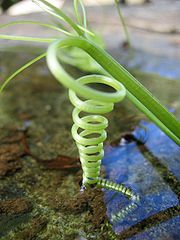
Helical growth
Encyclopedia

Algae
Algae are a large and diverse group of simple, typically autotrophic organisms, ranging from unicellular to multicellular forms, such as the giant kelps that grow to 65 meters in length. They are photosynthetic like plants, and "simple" because their tissues are not organized into the many...
or higher plant cells or organs leading to a twisted (i.e. helical) cell
Cell (biology)
The cell is the basic structural and functional unit of all known living organisms. It is the smallest unit of life that is classified as a living thing, and is often called the building block of life. The Alberts text discusses how the "cellular building blocks" move to shape developing embryos....
or organ shape. Helical growth results in the breaking of (usually radial) symmetry (biology)
Symmetry (biology)
Symmetry in biology is the balanced distribution of duplicate body parts or shapes. The body plans of most multicellular organisms exhibit some form of symmetry, either radial symmetry or bilateral symmetry or "spherical symmetry". A small minority exhibit no symmetry .In nature and biology,...
. Resulting shapes may be left-handed or right-handed. Helical growth can arise naturally (e.g. as seen in tendrils or in twining plants ) or artificially by mutation
Mutation
In molecular biology and genetics, mutations are changes in a genomic sequence: the DNA sequence of a cell's genome or the DNA or RNA sequence of a virus. They can be defined as sudden and spontaneous changes in the cell. Mutations are caused by radiation, viruses, transposons and mutagenic...
(Arabidopsis thaliana
Arabidopsis thaliana
Arabidopsis thaliana is a small flowering plant native to Europe, Asia, and northwestern Africa. A spring annual with a relatively short life cycle, arabidopsis is popular as a model organism in plant biology and genetics...
).
Helical growth of twining plants is based on a nutational movement
Nutation in plants
Nutation, in plants, is the bending movements executed by some plant organs, such as stems, leaves, roots, etc., by which the part is inclined successively in various directions. Nutations are due to the unequal rate of growth of different sides of the organ, an inequality which, so far as is known...
of stems (circumnutation). When such stems find support this nutational movement may become fixed into a helical winding. Most twining plants show right-handed helices regardless of the hemisphere the plant is growing in.
Helical growth of single cells, as seen in Phycomyces
Phycomyces
Phycomyces is a genus of fungus in the Zygomycota phylum. They are known for their strong phototropism response and helical growth of the sporangium. The best studied species is Phycomyces blakesleeanus.-External links:*....
(Fungi) and Nitella
Nitella
Nitella is a genus of alga in the family Characeae.- Species :Some species in the genus include:* Nitella acuminata A. Braun ex Wallman* Nitella annandalei B.P. Pal* Nitella australiensis J.C. van Raam...
(Characeae), is believed to be caused by a helical arrangement of microfibrils in the cell wall. This was suggested by birefringence analyses of cell walls. In Arabidopsis thaliana
Arabidopsis thaliana
Arabidopsis thaliana is a small flowering plant native to Europe, Asia, and northwestern Africa. A spring annual with a relatively short life cycle, arabidopsis is popular as a model organism in plant biology and genetics...
mutants helical growth is exhibited at the organ level. Mutant analysis strongly supports the idea that cortical microtubules have an important role in controlling the direction of organ expansion in plants. It is not clear how helical growth mutants affect cell wall assembly of Arabidopsis thaliana.

